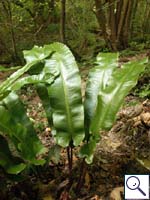|
||||||
|
PHYLLITIS. Hart's-toungue. [Aspleniaceae] |
|
|
Only one species of Phyllitis, Hart's-toungue (P. scolopendrium), is recorded in Britain. It is a native species. Phyllitis scolopendrium is treated as Asplenium scolopendrium by Stace (2010). Three British miners are recorded on Phyllitis. A key to the European miners recorded on Asplenium including Phyllitis is provided in Bladmineerders van Europa. |
|
Key for the identification of the known mines of British |
1a > Leaf-miner: Larvae usually feed on the underside of a fern frond under an untidy mass of sporangia, but on occasion enter the leaf to make an extensive irregular blotch mine. Usually the larva lives free under the leaf, under an inrregular mass of spun soredia and frass. The larva feeds on the sori, and larva betrays its presence as a sorus on an unusual place. Sometimes also elongate full depth blotches are made. |
|
Psychoides filicivora (Meyrick, 1937) [Lepidoptera: Tineidae]. |
1b > Leaf-miner: Full-depth corridor or blotch, often positioned along the leaf margin. In the first part much, brown-black, fine-grained frass, later parts of the mine almost free from frass. After hibernation the larva lives free in an untidy case of silk, covered with remants of sori. |
|
| Psychoides verhuella Bruand, 1853 [Lepidoptera: Tineidae]. |
1c > Leaf-miner: Larva forms a long greenish linear mine, frequently following a vein; mines can be up to 10 cm long. Pupation internal; anterior spiracles projecting through the leaf epidermis (Spencer, 1972b). Corridor, with the frass in an almost uninterrupted line along one side. In small leaves the corridor often follows the margin, but when space is not limited, like in Hart's-tongue Fern, it curves smoothly, not infrequently running over the midrib for some distance. Pupation mostly within the mine; the anterior spiracles then penetrate the epidermis. Forms a long narrow mine (up to 10cms). It is normally greenish and upper surface. |
|
Chromatomyia scolopendri (Robineau-Desvoidy, 1851) [Diptera: Agromyzidae]. |
| Last updated 25-Jan-2018 Brian Pitkin | ||

